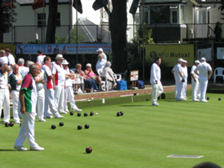Non Bias (Scottish) Carpet bowls
Non Bias (Scottish) Carpet Bowls.
This version of the game is played on a raised bed on a 24ft x
3ft carpet. The picture below taken from a 1936 catalogue gives an
idea of what the game looks like.
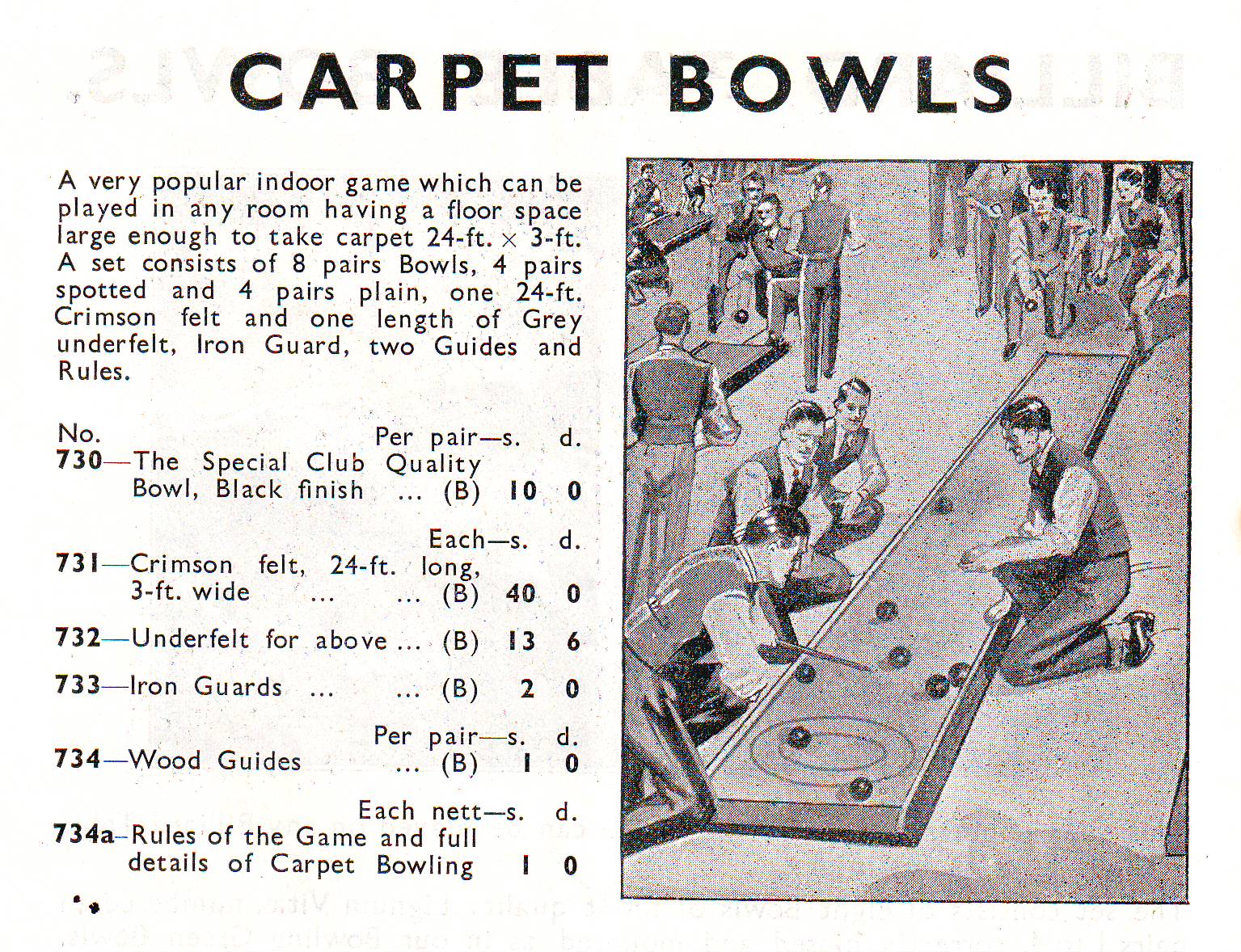
Picture acknowledgement- Norman Clare Heritage Collection
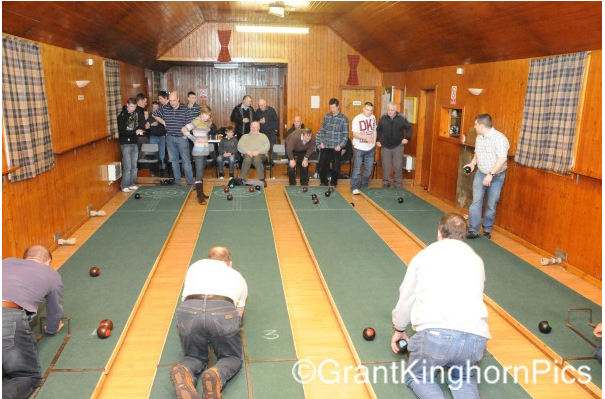
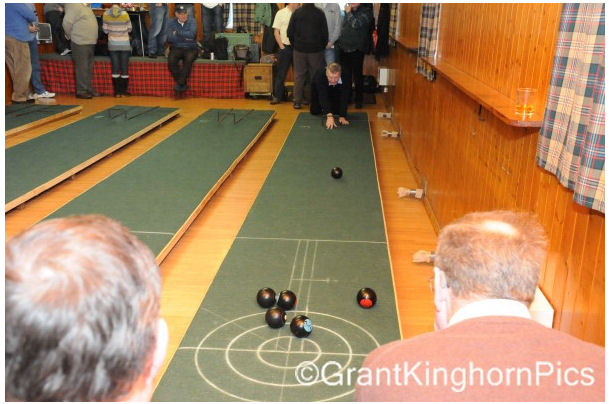
picture of Lindean Open Pairs
picture acknowledgement www.info@grantkinghornpics.co.uk
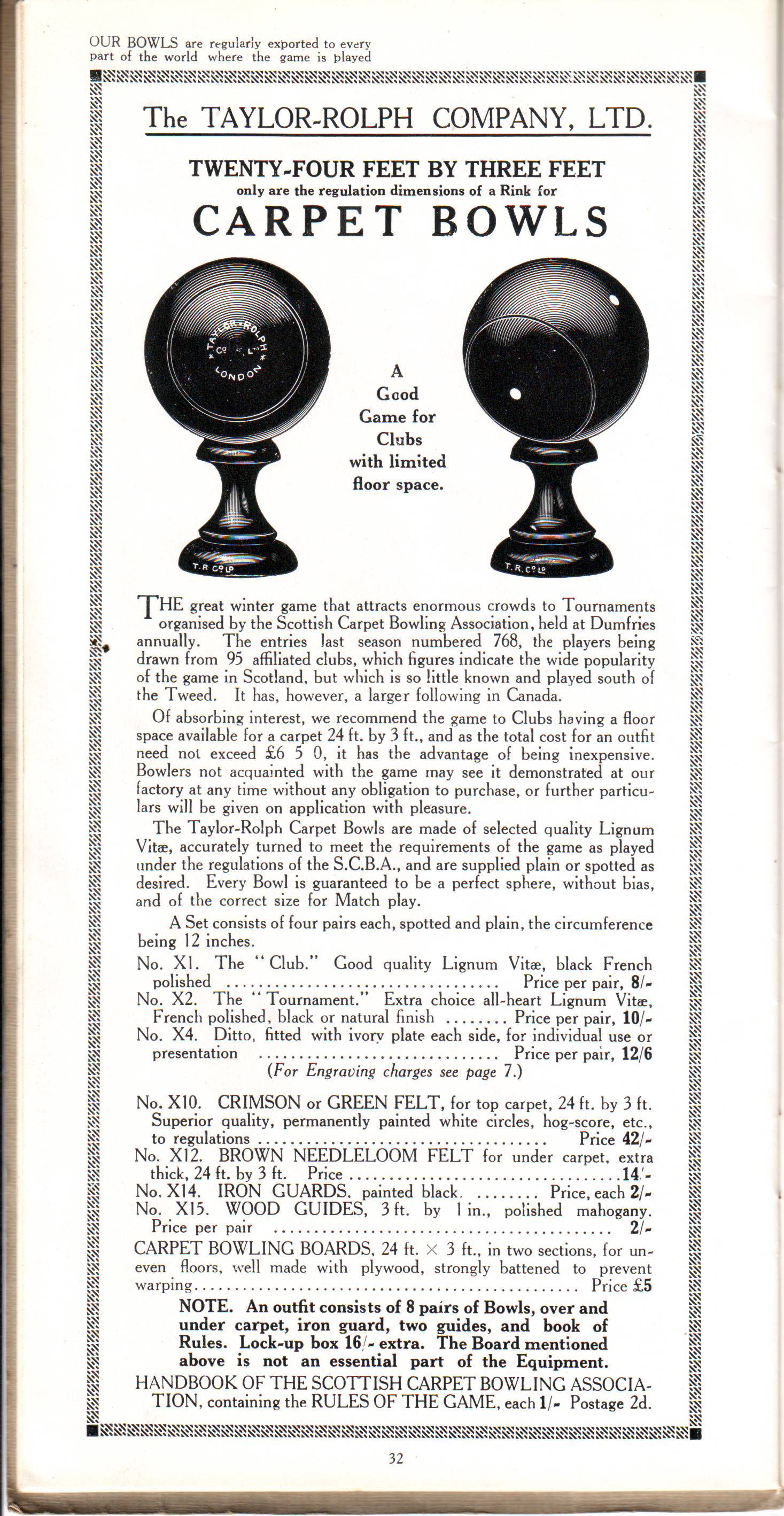
The above is a page from a Taylor-Rolph catalogue dated 1935. It
mentions that the Tournaments attract enormous crowds with 95
affiliated clubs in Scotland. It states that the game is little
know south of the Tweed but has a large following in Canada.
We are gratefull to the Birkenhead Carpet Bowling Society 1896
for allowing the use of information concerning both the history of
the game and its Rules.
further info Email bcbs1896@googlemail.com New
members always welcome
"Birkenhead Carpet Bowling Society 1896"
HISTORY
The origin of carpet bowling is unknown but it is believed to
have originated from a form of parlour game which used ceramic
bowls known in Scotland as 'Piggies'. This was extremely popular
between 1860 and 1880 as almost every home had a set of 'Piggies'.
As carpets were rare they used blankets, canvas or even paper; it
is recorded where one club played on sawdust spread on a hard
floor. This developed to where groups of young men began to
organise events with rules throughout Scotland. Some of these
young men also played the game of Curling. By the1890's the game
had developed with rules invented by some and copied from the new
rules put in place for curling. The measurement for the carpet and
markings are the same as that for curling but reduced from yards to
feet thus a third of the size of a curling rink.
By 1895 the Scottish Carpet Bowling Association had been formed
with 12 districts within Scotland. In the original form it did not
include England. Each district had anything between 5 and 10
member clubs. You can see from that that they had a membership in
the region of perhaps 100 clubs with average of 30/40 members
each. They were also responsible for arranging international
events which indicated that carpet bowls were being played
elsewhere to the same rules
It was a popular pastime and was encouraged by the churches to
"prevent young men from partaking in alcohol and mischief" and
local schoolrooms were often permitted to be used as bowling
halls.
In the early days there were no boards, just carpet laid on the
floor. Boards were introduced following the formation of the
association as the condition of many of the floors disadvantaged
visiting teams.
Ceramic bowls were used prior to 1895 when the association
decided on Lignum or a plastic substance called 'Lawrite
composition' and the size was set at no more than 12 inches
circumference. The problem of ceramic bowls hitting the 'wicket'
or hoop and shattering could now be avoided.
The first mention of carpet bowling in England follows the
formation of our club. The Birkenhead Carpet Bowling Society was
formed in 1896 by a group of drapers who originated from Dumfries.
It is believed that the first venue at that time was a hotel or
public house in Market Street, Birkenhead. Since then it has had
many venues throughout the town. Although it was formed by Scots
it had members from all sides of the community, English, Irish and
Welsh. In the North West region there soon came several other
clubs, the next formed being Chester. There was an international
fixture between England V Scotland in 1957, which incidentally
England won. There were many other tournaments both regional and
local. The most recent one is an annual fixture between Wrexham
and our club. Research shows that there are not many of these
clubs remaining. This may be due to the fact that the sport is not
widely publicised compared to others forms of bowling. Research is
vague but the Association seems to have been absorbed into the
Scottish Indoor Bowling Association (SIBA) during the mid 20th
Century.
This form of bowling is more affordable than short mat as the
carpets are approximately half the size and the bowls are half the
size; thus you only require a room which can accommodate a carpet
24' X3'. It is time for the sport to be reborn.
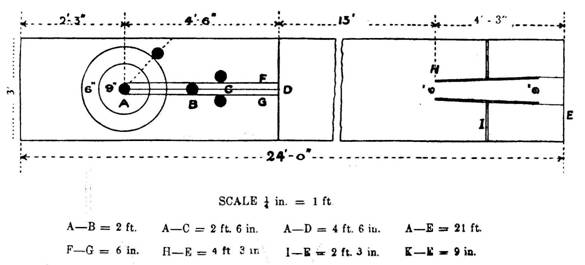
Rules of Play
1 a) the carpet should measure 24 feet long and 3 feet
wide
b) In the centre of the carpet, 21feet 9
inches from the playing end, a clearly defined tee shall be fixed.
Around such tee as a centre, a circle of 15 inches radius shall be
drawn. To facilitate measurements smaller circles may be drawn on
the inside of a smaller radius than the first.
c) A hog score line shall be drawn across
the carpet 4 feet 6 inches from the tee towards the playing
end.
d) Two guides made from wood 3feet 6inches long,
1 inch wide and ½ inch thick are to be fixed at the playing end of
the carpet. They should start 9 inches forward of the end of the
carpet and be 6 inches apart at the end nearest the tee and 9
inches apart at the playing end.
e) A guard mad of wood or metal about 5/8 inches
thick, 8 inches long and 43/4 inches high is to be fastened to the
carpet at the end of the wooden guides nearest to the tee.
f) At 27 inches from the playing end of the
carpet distinct lines shall be drawn from the edges of the
guides to the edge of the carpet, known as a delivery line. Every
player should place their hand, foot or knee behind that line. It
is a breach of the rules to deliver a bowl in a position where the
hand, foot or knee is on or beyond the line. All bowls being
played have to be delivered on the carpet between the two guides.
When a bowl being delivered leaves the players hand and passes
beyond the guard it shall be deemed a played bowl. The bowl must
be released before it passes through the guard.
2) All bowls must be made of wood or composite compound which
have been passed entirely free of loading or bias and not to
measure more than 12 inches in circumference.
3a) Every bowl shall be eligible to count which is not clearly
outside the 15 inch circle.
b) Each bowl past the tee and outside the 15inch circle
is considered out of play and laid off the carpet. Should there be
any dispute regarding a bowl on the 15 inch circle past the tee
while the game is in progress and appeal can be made to an umpire
for an immediate decision to decide whether the bowl is out of play
or not.
c) Each bowl shall be a hog which does not entirely
clear the hog line must be removed from the carpet. No bowl can be
considered as such if it has struck another bowl lying in a
position over the hog line. In the event of a dispute concerning
the hog line the captain or his nominee or an independent member
not being a member of either team involved may be asked to make a
decision which shall be deemed final.
4a) Should a bowl in play get broken another bowl shall placed
in the position where the largest fragment is situated. The player
is entitled to use another bowl for the remainder of the game.
b) On no other conditions can bowls be changed
after the game has commenced.
5a) Except as provided by the Regulations every rink is to be
composed of four players a side one of which shall be Skip, and
direct the game. Each player shall play two bowls.
b) The Skips opposing each other shall settle
which team shall lead at the first head after which the winning
side shall do so.
6a) The players on each side shall be the only persons
allowed to have any say in the game.
b) No person shall be allowed to be in contact with
the board while a player is in the act of delivering his bowl.
7) All matches to be of a certain number of heads as is
agreed at the Annual General Meeting.
8) Each player to be ready to play when their turn comes and
not to take more than a reasonable time to play. Should a wrong
bowl be played any player may stop it while running. If it is not
stopped while running they must wait until it comes to rest and it
may be replaced by the bowl that ought to have been played to the
satisfaction of the opposing skip.
9) Should a player play out of turn the bowl they played may
be stopped and returned to the player. Should the mistake not be
realised until the bowl is at rest or has struck another bowl the
opposing skip will have the option of declaring the end null and
void. If another bowl has been played before the mistake has been
realised the head must be finished as if it had been properly
played.
10) If a running bowl be marred by any of the party to whom
it belongs it may be by the challenge of opposing skip to be put
off the rink, but if by any of the adverse party it may be placed
where the skip of the party to whom it belongs shall direct if
otherwise marred, (except as provided for in rule 15) the player
shall replay the bowl.
Should any played bowl be displaced before the head is reckoned,
it shall be placed as near as possible to where it lay to the
satisfaction of the skip opposing to the party displacing it. When
no bowls are in the rink at the termination of the end this shall
be recorded as a played end.
11) No measuring of shots is allowed previous to the
termination of the end unless as in the latter part of Rule 3 b).
All disputed shots are to be determined by the captain or his
nominee. All measurements are to be taken from the centre of the
tee, that centre being clearly defined.
12) During the games players should be arranged along the side
of the carpet but well away from it, as the skip may direct. No
person shall kneel, walk, or rest on or over the carpet under any
pretext whatsoever whether or not a game is in progress.
13) If any player belonging to either of the competing sides
shall speak to, taunt or otherwise interrupt another not belonging
to their own party while in the act of playing their bowl, the said
player shall be warned against such conduct, and if they persist
shall be brought before the committee and shall be liable to
suspension or dismissal according to the fining thereof.
14) If a bowl passes underneath the guard it shall be deemed
a played bowl whether it strikes the guard or not and it shall be
allowed to run it's course. If the bowl passes over the guard,
passes by the side or bounces back from the guard it shall be
deemed out of play and the player shall not be allowed to replay
the same.
15) All disputes must be referred to the Captain, his nominee
and/or the secretary whose decision shall always be final.
16) Should any situation occur which is not covered by the
rules, the decision will be made by the committee in accordance
with fairness.
17) There shall be no smoking within the confines of the
playing area.
Disabled bowlers
Every possible assistance will be given to disabled bowlers to
allow them to compete on equal terms
with able bodied bowlers:-
a) b) If a walking stick, crutch or similar aid is essential
to give the bowler proper balance it shall be allowed.
c) Where a bowler requires the use of a length of guttering,
or similar, to be able to deliver his/her bowls, this will be
allowed. IF it is the ONLY way in which the
person concerned is able to deliver them.
d) At the discretion of the Committee, any member, either
disabled or otherwise, who requires to rest between ends,
shall be allowed to do so, but they must not wander away from the
rink.
Interpretation
Skip - Is the skipper or leader of a team and
plays fourth in the team
Hench - is henchman and deputy to the skip;
they play third in the team
Second - Is the player that plays second in the
team
Lead - Is the player that plays first in
the team
Tee - Is a point measured 21' 9" from the playing
end of the carpet and in the centre of the width
Guard - The metal or wooden guard at the end of
the guides through which a bowl must pass to be in play
Guides - Pieces of wood placed at
the players end
Hog - A line
drawn 4' 6" from the tee in direction of player
Rink
- A team of four players
Carpet - The area on
which the game is played
Wood - A bowl
regardless of whether it is wood or composite compound no more than
12" in circumference.
Reserve - A player
from a team is not allocated a game or who is not a permanent
member of a team
Circle - This is the scoring area within a radius of 15" from
the tee. Also referred to as the House.
House - This is alternative name for Circle.
End - Means that part of the game in which the two opposing
teams deliver eight woods alternately and then determine
the score
Game - Means
play between two teams to determine a winner.
Delivery line - Line drawn 27" from playing
end beyond which the player cannot exceed.
Wick
- Term applied to a bowl which glances off another bowl or
bowls to change its natural line of travel.
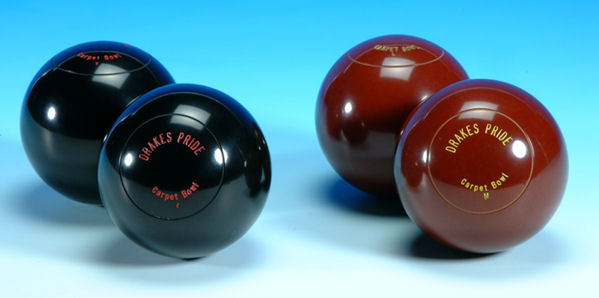
picture acknowledgement - Drakes Pride
© Peter N. Clare 2009 © E.A. Clare & Son Ltd. 2018 -
reproduction of article allowed only with permission from E.A.
Clare & Son Ltd.
